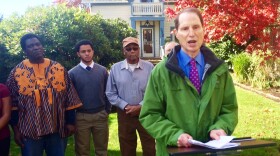An astrophysicist has used census data to create a map showing racial diversity in the U.S. KLCC’s Brian Bull reports on how Eugene fares.
Tomasz Stepinski combined satellite maps with census figures from 1990, 2000, and 2010.
The University of Cincinnati researcher says the computational data is meant as a sociological tool, and invites users to see trends of racial integration or segregation in their communities.

“Eugene is sorta boring, yes?" Stepinski tells KLCC.
"Because there is not dramatic change. And it is pretty uniform.”
Yet the map intrigues Eric Richardson, President of the Eugene-Springfield NAACP. He says it’s apparent that while the area remains predominantly white…
“…the majority of this map shows an increase in the Latino community," says Richardson. He compares the 1990 and 2010 maps in the KLCC studios.

"Right here at the top…a full-on Latino piece that was not there in 1990. So we have a truly dynamic demographic change occurring. And it does have to do with our Latino brothers and sisters.”
Eugene’s Latino population is roughly 8 percent, compared to nearly 3 percent in 1990.
The map can be accessed from the University of Cincinnati's Space Infomatics Lab Website.
Copyright 2017, KLCC.








